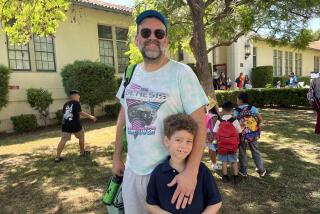L.A.’s War-Weary Children
- Share via
The Journal of the American Medical Assn. published a special issue this month on violence and human rights. Amid reports on the psychological effects of terrorist attacks on Israel and of land-mine injuries in Afghanistan is a study on treating post-traumatic stress disorder -- in East Los Angeles sixth-graders.
In a city with so many gunshot victims that Navy surgeons come to it to practice combat medicine, it shouldn’t come as a shock that children who are witnesses to and victims of gang wars display symptoms most people associate with Vietnam veterans. But it does.
It shocked Marleen Wong, director of crisis counseling for the Los Angeles Unified School District, who turned to the Rand Corp. and UCLA to develop the treatment described in the journal.
Four years ago, while working with recent immigrants in heavily Latino Eastside neighborhoods, Wong began asking students what challenges they faced in adjusting to their new schools. She expected to learn about language and cultural roadblocks. Instead she heard about drive-by shootings.
Whether immigrant or U.S.-born, an astonishing 9 out of 10 children she surveyed had been punched, shot at, threatened with a gun or a knife or seen someone hit, shot or stabbed. Of these, 27% were easily startled, had difficulty concentrating and couldn’t stop thinking about the speeding car or blood-splattered body they had seen -- classic symptoms of post-traumatic stress disorder. Others showed signs of clinical depression.
“These weren’t kids who were necessarily acting out,” Wong says. “These were kids hidden in plain sight ... suffering silently.”
It’s rare enough for local leaders to turn to think tanks and universities for help, as Wong and her LAUSD bosses did. Rand Corp. and UCLA researchers in turn put aside their ivory-tower ways to move quickly and work closely with school officials to develop treatments that could be used in a real-world setting.
The result was a practical, 10-session group-counseling program led by trained LAUSD social workers at little extra cost and with minimal disruption of class time. And, unlike so many well-meaning social programs, this one withstood randomized, controlled studies to see whether it worked. As reported in the medical association journal, students showed a significant decrease in stress and depression.
“It really did show tremendous leadership and commitment on the LAUSD side and on Rand’s side,” says Rand’s Bradley D. Stein, the lead author of the study. “If there’s a commitment to doing this from both sides, it can result in something remarkable.”
If that kind of collaboration can be applied to L.A. Bridges and other city programs that aim to keep kids from joining gangs, then some day Los Angeles may no longer need to treat its children for the aftershocks of war.






